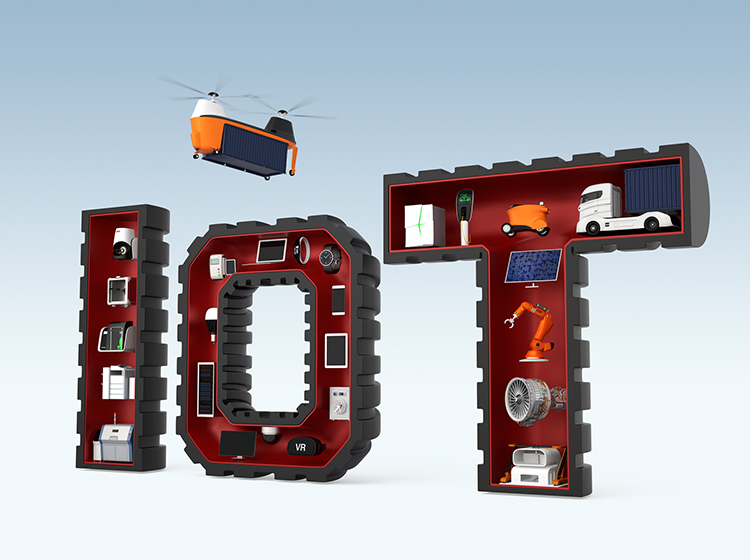As the internet increasingly becomes an integral part of our daily lives, so too does the likelihood that someone will say ‘if it can do this, maybe it could do that’. Before we know it, the interconnectivity of knowledge, technology and application will be woven throughout everything we do – including transport and logistics.
We’ve fast become reliant on having GPS in our cars, and swiping cards to buy petrol and groceries. There are now alarm clocks that can turn on the coffee machine and brew the perfect cup, ready the moment you walk into the kitchen. Alongside them are refrigerators that order a litre of milk or stick of butter because supplies are getting low.
These exchanges all happen through built-in electronics, sensors, software and connectivity that allow the movement and collection of information – the internet of things.

What is the internet of things?
The internet of things (IoT) is a term describing a giant global network of connected ‘things’. Those things might be interrelated computers, digital machines and mechanical equipment. They could also be objects, vehicles, animals and people, all with unique identifiers and the ability to transfer data over a network without the need for human-to-human or human-to-computer interaction. It is that data that offers immense value to supply and logistics businesses.
It’s predicted that by 2020, 25 billion ‘things’ will be connected to the internet, including more than 250 million vehicles worldwide.1 These ‘things’ are gathering insightful data to create valuable business outcomes.
The applications made possible through implementation of the IoT are endless and wide-ranging, giving businesses new ways to use data and technology to improve systems and reduce costs. They might include any of the following:
- Energy management through use of smart meters, monitoring usage and managing peak loads.
- Automotive technology, including fatigue and traffic management, safety and guidance features.
- Remote health monitoring.
- Logistics solutions, enabling supply organisations to more effectively plan and manage stock, transport and delivery.
- Security solutions involving not just cameras and detectors, but real-time remote access.
- Smart cities, offering better infrastructure, transport and liveability.
- Smart homes, managing energy usage and security.
How will the IoT aid supply chain and logistics?
Viva Energy recently attended a summit hosted by Australian Road Transport Suppliers Association (ARTSA) where Charlie Macdonald, an industry executive in manufacturing, transport and logistics for Telstra Global Industries, presented on technology trends. The presentation covered how technologies are converging to create a transport and logistics industry where systems are tracked, optimised and constantly being improved. The information that follows was drawn from his presentation.
The IoT encompasses standalone applications such as traffic management systems, and information and warning systems in individual vehicles, as well as cooperative intelligent transport system (ITS) applications involving vehicle-to-vehicle and vehicle-to-infrastructure communications. Businesses can harness these to create fleet efficiencies, saving fuel and time costs through monitoring real-time traffic conditions and taking alternative routes to avoid delays.
In-transit visibility is heightened through a combination of radiofrequency identification (RFID) and cloud-based technologies that provide real-time data with regard to location, temperature control and time of arrival.
The IoT can also be used by businesses to track products from the point of manufacture to the point of sale, thereby reducing stock losses and inventory and labour costs through the following areas of activity:
- Every element in the supply chain, from stock to vehicles, can be fitted with RFID transponders or GPS-enabled micro-computers that continuously collect data and feed it back into transport management and/or inventory systems.
- Real-time data allows progressive tracking of all elements while in transit, from location and stock temperature through to road conditions, weather, traffic congestion and even driver fatigue. Monitors are able to advise on alternate routes, driver safety and mechanical issues and update order tracking as necessary.
- Information streams create an invaluable, ongoing source of data which can be analysed in real time or offline. This gives business managers the opportunity to make informed decisions, thereby optimising the operations of all elements within the system.
The move to the IoT is being driven by the diminishing cost of digital processing and data storage, improved monitoring technologies and the development of cloud storage systems and wireless data transmission.2
The internet of things is here, and is an integral part of our future. What businesses need to do now is become agile and ‘smart’ enough to take advantage of the technology and the insights generated from the data.
1Gartner, 'Gartner Says By 2020, a Quarter Billion Connected Vehicles Will Enable New In-Vehicle Services and Automated Driving Capabilities', 26 January 2015,
2Global Heavy Vehicle Leaders Summit, May 2016, Technology Trends, Charlie Macdonald, Telstra Global Industries.
Viva Energy's products are transported all over Australia.
Find out more about them here